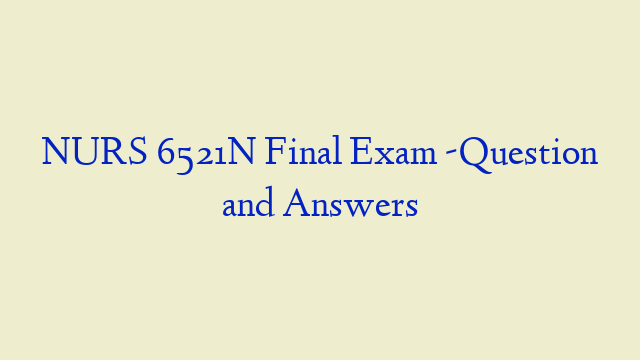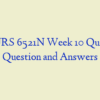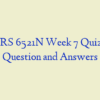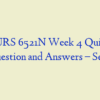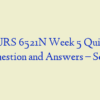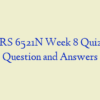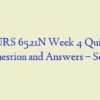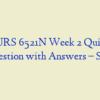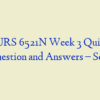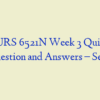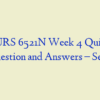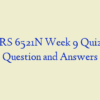Description
NURS-6521N-20,Advanced Pharmacology
NURS-6521C-29/NURS-6521N-29-Advanced Pharmacology – Exam – Week 11
95 out of 100 points
- A male patient is trying to decide if he should use finasteride (Proscar) to treat benign prostatic hypertrophy (BPH). When providing information about the drug, the nurse will include which of the following as a risk associated with finasteride therapy?
- Excess fluid volume related to potential effects of drug therapy
- Corticosteroids
- Azithromycin in
- Decrease noise and light in the environment
- A Nurse Practitioner is providing patient education to a 50-year-old woman who is taking methotrexate (MTX) for breast cancer. The nurse will instruct the patient to avoid which of the following drugs?
- When a NP chooses a benzodiazepine to treat anxiety the prescriber needs to be aware of the possibility of dependence. The Benzodiazepine associated with the greatest likelihood of causing rapid dependence is:
- Mr. Asberry is taking Levofloxacin for his sinusitis. He calls your clinic and reports some pain just above the heel of his left foot. The NP should:
- Which of the following patients will be at the greatest risk for anemia and would be the most likely candidate for epoetin alfa therapy?
- Which of the following is a true statement about aspirin and its action on platelets
- A nurse practitioner orders 150 mg of oral fluconazole for a patient with vulvovaginal candidiasis. The patient should expect to take medication
- A Nurse Practitioner will monitor which of the following when assigned to a patient taking allopurinol for chronic gout who visits the clinic every 2 months?
- A 46-year-old man is receiving a quinupristin/dalfopristin IV infusion for a life-threatening infection. Which of the following would be most important for the nurse to monitor?
- A 38-year-old pregnant patient admits to the Nurse Practitioner that she is an alcoholic and has been consuming alcohol during her pregnancy. The nurse knows that using alcohol during pregnancy may result in a child who presents with
- The nurse practitioner orders Amoxicillin 500 mg tid? What is the total amount of medication patient will take per day?
- A quinolone used to treat a urinary tract infection would be contraindicated in :
- A nurse practitioner has administered filgrastim to a diverse group of patients in recent months. Which of the following patients should the nurse observe for extremely elevated white blood cell counts following administration of the drug?
- Laboratory testing has confirmed that a patient has chloroquine-resistant malaria and the patient’s physician has prescribed quinine along with an adjunctive drug. The nurse should question the physician’s order if the patient has a history of
- An immunocompromised patient in a critical care setting has developed a respiratory infection that has been attributed to methicillin-resistant Staphylococcus aureus (MRSA). The nurse should anticipate that the patient will require treatment with
- A 29-year-old pregnant patient is extremely upset about having to take medication for a pre-existing medical condition. She is consumed with fear that her baby will be born with a physical deformity or a congenital anomaly but knows that she has to take the medication. She talks constantly about this and is unable to sleep most nights. Which of the following is the most appropriate nursing diagnosis for this patient is?
- The NP student knows that which statement below accurately describes the activity of naloxone?
- Mr. Singh is a 66-year-old man who is receiving chemotherapy for the treatment of lung cancer that has metastasized to his liver. In an effort to prevent infection, Mr. Singh has been prescribed filgrastim (Neupogen). Which of the nurse’s following assessment questions most directly addresses a common adverse effect of filgrastim?
- The nurse practitioner, Jill, is deciding what medication to put her patient on. She recognizes that the mechanism of action of triptans is as:
- What schedule drug is alprazolam?
- A 30-year-old African-American woman tested positive for TB and is prescribed isoniazid. The nurse will plan the patient’s care to include close monitoring of the drug therapy because
- Which of the following medication classes should be avoided and men with BPH
- Which of the following drugs can a person with G6PD deficiency take safely?
- A 2-year-old child is diagnosed with a minor ailment and is to be administered medications at home for 2 weeks. The child lives with his mother, grandmother, and four other children between the ages of 14 months and 7 years. The home health nurse is asked to assess the home environment to determine if it is appropriate for the child to take his medication at home. Which of the following will have the greatest impact on the nurse’s assessment?
- The recommended treatment for trichomoniasis is
- A Nurse Practitioner who provides care on a pediatric unit of a hospital is aware that the potential for harm as a result of drug errors is higher among infants and children than adults. This fact is primarily due to
- A patient is to begin taking tobramycin (Nebcin) for a nosocomial infection. Which of the following assessments should the nurse prioritize?
- Lily, the nurse practitioner is seeing Mr. Reynolds today. She would recognize that which of the following is a potential adverse side effects of autonomic-anticholinergic agents?
- A Nurse Practitioner is reviewing the prepregnancy medication regimen of a patient who has just had a positive pregnancy test. The nurse should be
- Increased drug distribution resulting from hemodynamic changes
- A patient is taking etoposide for a testicular tumor refractory to treatment. The nursing assessment reveals that he is also taking warfarin. The nurse must carefully monitor for which of the following?
- A patient reports to a clinic with complaints of breast tenderness, a right lumpy breast, and no breast discharge. The breast tenderness occurs primarily during her menstrual cycle. The nurse practitioner probably suspects
- John, the Nurse Practitioner is prescribing Fosamax for his patient. Bisphosphonate administration education includes
- An oncology nurse is reviewing the pathophysiology of cancer and is discussing with a colleague the factors that contribute to the success or failure of a patient’s chemotherapy. Which of the following cancerous cells is most susceptible to the effects of chemotherapeutic drugs?
- A Nurse Practitioner is working with a 57-year-old man who is a former intravenous drug abuser. He has been prescribed a weekly dosage of methotrexate for his rheumatoid arthritis. Which of the following will the nurse include in her teaching plan for this patient?
- Which antibiotic is most frequently associated with “Red man Syndrome”
- A patient with non-Hodgkin’s lymphoma (NHL) will be starting a course of doxorubicin shortly. When planning this patient’s care, what nursing diagnosis should the nurse prioritize?
- Risk for Infection related to suppressed bone marrow function
- A patient with a recent diagnosis of chronic myelogenous leukemia (CML) is discussing treatment options with his care team. What aspect of the patient’s condition would contraindicate the use of cyclophosphamide for the treatment of leukemia?
- A 13-year-old patient has juvenile arthritis. He has recently had oral surgery and was told by the surgeon to take aspirin for the pain. The APRN will monitor for which of the following?
- Which of the following drugs is most likely to cause sexual dysfunction and males?
- A postmenopausal patient is prescribed bisphosphonates to treat osteoporosis. The nurse will instruct the patient to take the drug
- The NP is teaching a patient about TMP/SMX before prescribing it to treat a UTI. Which statement by the patient indicates a need for further teaching?
- A man is prescribed ciprofloxacin to treat a sexually transmitted infection. The nurse will instruct the patient to
- Alendronate (Fosamax) is prescribed for a 67-year-old postmenopausal woman. In order to help prevent gastrointestinal distress, the nurse will advise the patient to
- The clinical nurse educator who oversees the emergency department in a
- After 6 months of unsuccessfully trying to conceive, a 31-year-old woman and her husband have sought a referral to a fertility specialist in order to explore their options. A nurse at the clinic should recognize that the woman may benefit from
- A 7-year-old child has tonsillitis and is prescribed penicillin V, which is to be administered at home. The nurse will instruct the parents to administer the drug
- A patient has been prescribed oral tetracycline. The nurse will instruct the patient to take the drug
- Jennifer, the Nurse Practitioner, is seeing Mr. Johns, a 65 year old male in the clinic today with c/o Arthritis pain. What is a serious side effect of ibuprofen use in the older adult patient?
- How is hydrocodone eliminated from the body? Selected Kidne
- Phenytoin decreases folic acid absorption by
- Which of the following should not be taken with a selective serotonin reuptake inhibitor?
- A school nurse has been teaching high school students about the risks associated with marijuana use. However, the nurse has been met with considerable skepticism on the part of students, most of whom believe that marijuana is a benign drug. Which of the following teaching points should the nurse provide?
- Sulconazole has been prescribed for a patient with tinea pedis. The nurse will instruct the patient to use the topical agent
- A Nurse Practitioner has completed a medication reconciliation of a patient who has been admitted following a motor vehicle accident. Among the many drugs that the patient has received in the previous year is rituximab. The nurse would be justified in suspecting the patient may have received treatment for which of the following diseases?
- A Nurse Practitioner is providing patient education to a 13-year-old girl who was just diagnosed with type 1 diabetes mellitus. Which of the following statements by the patient will alert the nurse that special instructions regarding insulin are necessary?
- A patient is taking flavoxate hydrochloride (Urispas) to help control an overactive bladder. On a follow-up visit to the clinic, the nurse will question the patient about which of the following?
- A 20-year-old woman has been prescribed estrogen. As with all women taking estrogen, the nurse will carefully monitor the patient for which of the following?
- A nurse practitioner has been assigned to a 55-year-old woman who has a malignant brain tumor. The patient is receiving her first dose of carmustine. It will be critical for the nurse to observe for which of the following?
- A patient is prescribed ganciclovir to treat a CMV infection. An oral dosage is prescribed. To help increase bioavailability of the drug, the nurse will encourage the patient to take the medication
- A Nurse Practitioner is assessing a patient who has chronic lymphoblastic myelogenous leukemia. The treatment plan includes hydroxyurea (Hydrea). The nurse will assess the patient for which of the following?
- A 20-year-old woman will soon begin taking oral contraceptives for the first time. What advice should the nurse provide to this patient?
- Ms. Shackleford Has been placed on Ambien to help for her insomnia. The NP must educate the patient regarding the rapid onset of Ambien. Which statement below is correct?
- A Nurse Practitioner is caring for a patient who is on amphotericin B. On morning rounds the patient reports weakness, numbness, and a tingling sensation in his feet. What would be a priority action by the nurse?
- A male patient is receiving heparin by continuous intravenous infusion. The nurse will instruct the patient and family members to report which of the following should it occur?
- A 66-year-old woman has experienced a significant decline in her quality of life as a result of worsening rheumatoid arthritis. Her physician has prescribed etanercept and the APRN is responsible for facilitating this new aspect of the patient’s drug regimen. This will involve the administration of
- Mr. Laird is a 49-year-old electrician who experienced severe burns on his trunk, arms, and hands in a workplace accident 2 weeks ago. Part of his current wound care regimen involves the daily application of silver sulfadiazine to his wounds. The nurses who are providing care for Mr. Laird in the burns and plastics unit of the hospital should perform what action when administering this medication?
- A Nurse Practitioner is going to administer medication to an infant using a medicine dropper. The best method is to open the child’s mouth by gently squeezing the cheeks and placing the drops
- A Nurse Practitioner is caring for a patient who is at 28 weeks’ gestation and is receiving terbutaline (Brethine) to control preterm labor. Which of the following assessment parameters should the nurse prioritize?
- A 20-year-old female patient is receiving topical clindamycin for acne vulgaris. She develops a rash and urticaria along with severe itching where the medication is applied. The nurse will formulate which of the following nursing diagnoses for the patient?
- A patient with chronic heart failure has begun treatment with epoetin alfa, which she will receive in her own home from a home health nurse. The nurse should teach the patient to supplement this treatment with a diet that is high in
- A female patient is taking filgrastim (Neupogen) to decrease the incidence of infection. The nurse notices a small increase in the neutrophil count 2 days after starting therapy. The nurse’s evaluation of the increase is that
- A 5-year-old boy needs an IM injection. The least painful and most effective injection site would be the
- Monitoring of male patients are using phosphodiesterase type 5 (PDE-5) inhibitors includes which of the following?
- A Nurse Practitioner is caring for a 10-year-old boy who complains of chronic headaches. His mother reports that she gives him Tylenol at least three times a day. Which of the following will the nurse work with the physician to evaluate?
- Which of the following agents would not be expected to cause nausea, vomiting, Flushing, dizziness, headache, and abdominal discomfort after consumption of alcohol?
- What is the first line treatment for hypertension and a male with benign prosthetic hypertrophy?
- How do bisphosphonates Treat osteoporosis?
- A Nurse Practitioner is explaining the use of acyclovir therapy to a 72-year-old man. Nephrotoxicity is discussed as a major adverse effect in older patients. To minimize the risk of the patient developing this adverse effect, the nurse will advise him to
- A 43-year-old man has been diagnosed with active TB. He has prescribed a multiple drug therapy, including INH and rifampin. A priority assessment by the nurse will be to monitor which combination of laboratory test results?
- Some drugs are given to patients using other routes such as sublingual or topical to avoid movement through the liver and possible side effects. Which of the following effects is the Nurse Practitioner attempting to avoid by administering certain medications via alternative routes?
- A man has a demonstrated history of androgen deficiency and the consequences of this health problem include an inability to maintain an erection. Which of the following medications would best address this patient’s erectile dysfunction (ED)?
- The NP is reviewing Mrs. Oglethorpe’s medication list and recognizes that which drug listed below has been associated with increased risk for MI in women?
- On the advice of her sister, a 52-year-old woman has visited her nurse practitioner to discuss the potential benefits of hormone replacement therapy in controlling the symptoms of menopause. Which of the following responses by the nurse is most appropriate?
- A 65-year-old woman has an advanced form of rheumatoid arthritis. Her treatment includes a regular dosage of methotrexate. The APRN will advise her to take which of the following vitamin supplements while taking the drug?
- Gold compounds are contraindicated in patients with a lof the folowing conditions except:
- A Nurse Practitioner is aware that the concept of selective toxicity is foundational to antimicrobial therapy. Which of the following statements most accurately describes selective toxicity?
- A 29-year-old woman who is morbidly obese has recently begun a comprehensive, medically-supervised program of weight reduction. Prior to adding dextroamphetamine (Dexedrine) to her regimen, the patient should be questioned about her intake of
- Ms. Carter, a 48 year old female was placed on an aminoglycoside. The NP knows that an adverse reaction to aminoglycosides is?
- A male patient is taking finasteride for BPH. Which of the following will the nurse evaluate at each clinic visit?
- A woman is receiving magnesium sulfate for intrapartum eclampsia. The patient is perspiring and her blood pressure is 88/50. The serum magnesium level is 10 mg/dL. The nurse will interpret these manifestations as
- A 62-year-old patient taking tamoxifen exhibits increased bone and tumor pain along with a local disease flare. The nurse interprets this as an indication of which of the following?
- Ms. Lewis Is in 74-year-old female who presents to your clinic for routine visit today. You review her medical record and notice she is prescribed aspirin therapy. You provide patient education regarding the signs of aspirin toxicity. An early sign of aspirin toxicity is:
- During ongoing assessment of a patient receiving 5-FU therapy, the nurse finds the patient’s platelet count to be 92,000 cells/mm3. The nurse should do which of the following?
- An immunocompromised 7-year-old child was recently discharged home with a peripherally-inserted central line (PIC line) for home antibiotic therapy. He has now been brought to the emergency department by his mother and father with signs and symptoms of line sepsis. Upon questioning, the mother states that she has been removing the PIC dressing daily and washing the site with warm water and a cloth. What nursing diagnosis is most appropriate in this situation?
